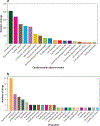Human Induced Pluripotent Stem Cell (hiPSC)-Derived Cells to Assess Drug Cardiotoxicity: Opportunities and Problems
- PMID: 28992430
- PMCID: PMC7386286
- DOI: 10.1146/annurev-pharmtox-010617-053110
Human Induced Pluripotent Stem Cell (hiPSC)-Derived Cells to Assess Drug Cardiotoxicity: Opportunities and Problems
Abstract
Billions of US dollars are invested every year by the pharmaceutical industry in drug development, with the aim of introducing new drugs that are effective and have minimal side effects. Thirty percent of in-pipeline drugs are excluded in an early phase of preclinical and clinical screening owing to cardiovascular safety concerns, and several lead molecules that pass the early safety screening make it to market but are later withdrawn owing to severe cardiac side effects. Although the current drug safety screening methodologies can identify some cardiotoxic drug candidates, they cannot accurately represent the human heart in many aspects, including genomics, transcriptomics, and patient- or population-specific cardiotoxicity. Despite some limitations, human induced pluripotent stem cell-derived cardiomyocytes (hiPSC-CMs) are a powerful and evolving technology that has been shown to recapitulate many attributes of human cardiomyocytes and their drug responses. In this review, we discuss the potential impact of the inclusion of the hiPSC-CM platform in premarket candidate drug screening.
Keywords: cardiac; cardiomyocyte; cardiotoxicity; chemotherapy; differentiation; human induced pluripotent stem cells; pharmacogenomics.
Figures



Similar articles
-
Drug screening using a library of human induced pluripotent stem cell-derived cardiomyocytes reveals disease-specific patterns of cardiotoxicity.Circulation. 2013 Apr 23;127(16):1677-91. doi: 10.1161/CIRCULATIONAHA.113.001883. Epub 2013 Mar 21. Circulation. 2013. PMID: 23519760 Free PMC article.
-
Use of human induced pluripotent stem cell-derived cardiomyocytes to assess drug cardiotoxicity.Nat Protoc. 2018 Dec;13(12):3018-3041. doi: 10.1038/s41596-018-0076-8. Nat Protoc. 2018. PMID: 30413796 Free PMC article.
-
Moving beyond the comprehensive in vitro proarrhythmia assay: Use of human-induced pluripotent stem cell-derived cardiomyocytes to assess contractile effects associated with drug-induced structural cardiotoxicity.J Appl Toxicol. 2018 Sep;38(9):1166-1176. doi: 10.1002/jat.3611. Epub 2018 Feb 27. J Appl Toxicol. 2018. PMID: 29484688 Review.
-
Clinical Trial in a Dish: Using Patient-Derived Induced Pluripotent Stem Cells to Identify Risks of Drug-Induced Cardiotoxicity.Arterioscler Thromb Vasc Biol. 2021 Mar;41(3):1019-1031. doi: 10.1161/ATVBAHA.120.314695. Epub 2021 Jan 21. Arterioscler Thromb Vasc Biol. 2021. PMID: 33472401 Free PMC article. Review.
-
Screening drug-induced arrhythmia [corrected] using human induced pluripotent stem cell-derived cardiomyocytes and low-impedance microelectrode arrays.Circulation. 2013 Sep 10;128(11 Suppl 1):S3-13. doi: 10.1161/CIRCULATIONAHA.112.000570. Circulation. 2013. PMID: 24030418 Free PMC article.
Cited by
-
Next generation of heart regenerative therapies: progress and promise of cardiac tissue engineering.NPJ Regen Med. 2021 Jun 1;6(1):30. doi: 10.1038/s41536-021-00140-4. NPJ Regen Med. 2021. PMID: 34075050 Free PMC article. Review.
-
Functional isolation, culture and cryopreservation of adult human primary cardiomyocytes.Signal Transduct Target Ther. 2022 Jul 27;7(1):254. doi: 10.1038/s41392-022-01044-5. Signal Transduct Target Ther. 2022. PMID: 35882831 Free PMC article.
-
Stem Cells and Organoids: A Paradigm Shift in Preclinical Models Toward Personalized Medicine.Pharmaceuticals (Basel). 2025 Jul 1;18(7):992. doi: 10.3390/ph18070992. Pharmaceuticals (Basel). 2025. PMID: 40732281 Free PMC article. Review.
-
Thorough QT/QTc in a Dish: An In Vitro Human Model That Accurately Predicts Clinical Concentration-QTc Relationships.Clin Pharmacol Ther. 2019 May;105(5):1175-1186. doi: 10.1002/cpt.1259. Epub 2018 Dec 2. Clin Pharmacol Ther. 2019. PMID: 30346629 Free PMC article.
-
Characteristics of Bisphenol Cardiotoxicity: Impaired Excitability, Contractility, and Relaxation.Cardiovasc Toxicol. 2022 Mar;22(3):273-280. doi: 10.1007/s12012-022-09719-9. Epub 2022 Feb 10. Cardiovasc Toxicol. 2022. PMID: 35143014 Free PMC article. Review.
References
-
- Arrowsmith J, Miller P. 2013. Trial watch: phase II and phase III attrition rates 2011–2012. Nat. Rev. Drug Discov 12:569. - PubMed
-
- US Food Drug Admin. 2015. Reports received and reports entered into FAERS by year In FDA Adverse Event Reporting System (FAERS). Silver Spring, MD: US Food Drug Admin; https://www.fda.gov/Drugs/GuidanceComplianceRegulatoryInformation/Survei....
-
- van der Hooft CS, Heeringa J, Brusselle GG, Hofman A, Witteman JC, et al. 2006. Corticosteroids and the risk of atrial fibrillation. Arch. Intern. Med 166:1016–20 - PubMed
Publication types
MeSH terms
Grants and funding
LinkOut - more resources
Full Text Sources
Other Literature Sources
Medical

